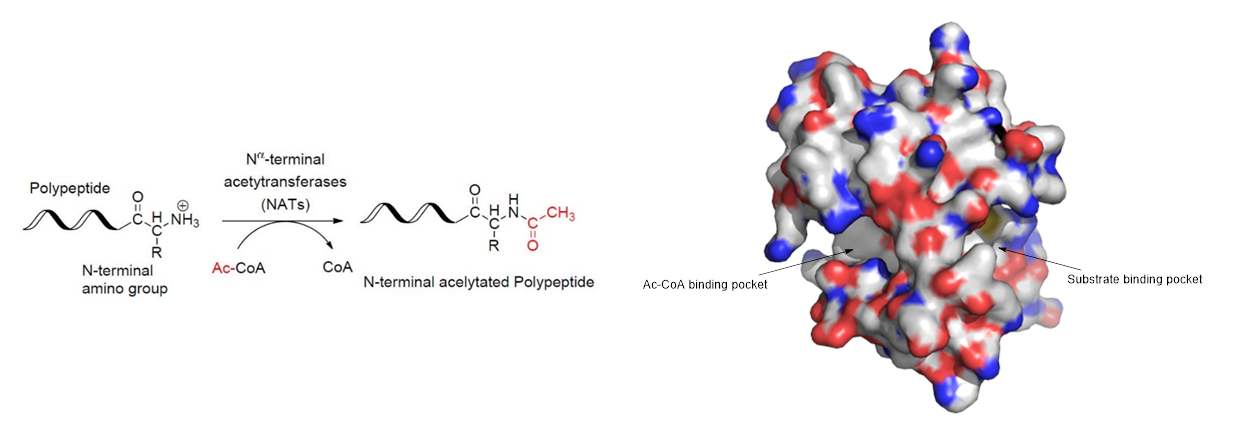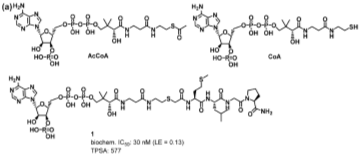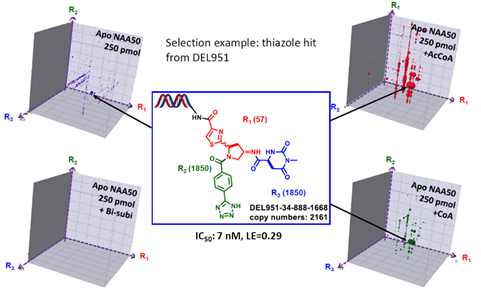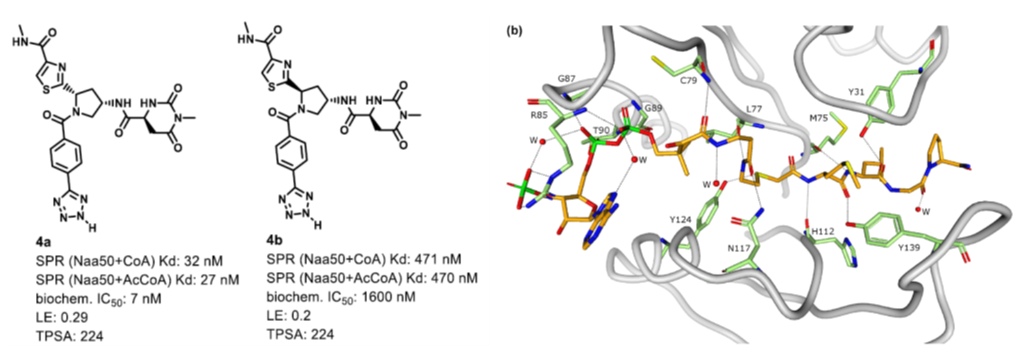HitGen has established a drug discovery research platform for small molecules and nucleic acid drugs centered on the design, synthesis and screening of DNA encoded chemical libraries (DELs), fragment-based drug discovery (FBDD) and structure-based drug design (SBDD) technologies.
Collaboration Project with Pfizer, ACS Med. Chem. Lett. 2020, 11, 1175−1184
Protein NAA50 and its Function
The N-terminal-acetylation of a protein can affect its nuclear import and export and can also act as a degradation signal to control the protein’s cellular stability. The Nα-terminal acetyltransferase (Naa50) enzyme is a member of the Nα-terminal acetyltransferase NAT protein family. It coexists with Naa10 and Naa15 in the NatE complex and is responsible for the enzymatic function of the complex. Naa50 is also found to be essential for normal sister chromatid cohesion and chromosome condensation. Therefore, an inhibitor of the Naa50 enzyme might have therapeutic applications in oncology indications. The enzymatic catalysis and protein structure are shown below.

NAA50 Known Inhibitor and Objective of DEL Selection
Compound 1 is designed by studies of the NAA50 biochemical mechanism which indicated formation of a ternary complex between the AcCoA cofactor, an appropriate protein substrate (tetra-peptide MLGP), and the enzyme. Although compound 1 is a potent Naa50 inhibitor, the molecule is not particularly efficient due to its large molecular weight (ligand efficiency (LE)10 = 0.13). In addition, its high molecular weight (MW = 1223) and high polarity (tPSA = 577 and cLogP = −4.1) likely prevents facile permeability across cell membranes and may thus compromise the use of the molecule as a robust in vitro tool compound.
The DEL selection is to identify potent and selective NAA50 inhibitors with improved physiochemical properties relative to compound 1 (i.e., reduced molecular weight and tPSA; increased logD).

DEL Selection Plan
In a typical DEL selection plan, we set up 3 samples (1. protein alone, Apo NAA50 in this case; 2. protein and inhibitor in saturated concentration; 3. Blank control). However, during the studies of NAA50, we realized that NAA50 protein involves conformational change in the catalytical process. By comparison of selection results of Sample 1 and 2 aforementioned, we are not able to effectively identify inhibitors. Consequently, we included two additional samples by addition of AcCoA and CoA, seeking for compounds binding to the transition state. The final Selection Plan are summarized below.

Representative DEL Selection Results
DEL selection is typically presented in a cubic layout, where the axis represents the corresponding building block and bubble size represents the sequence count of each compound. If the compounds have more engagement to the protein (high binding affinity or slow off-rate), the sequence counts will be presented as bigger bubbles. As we can see from the first four samples (blank sample 5 is now shown), Apo NAA50, Apo NAA50 + AcCoA, Apo NAA50 + CoA and Apo NAA50 + Compound 1 (also called Bi-subi) resulted different enrichment pattern, proving that NAA50 has conformational changes during the catalysis. Selection of compounds binding to all the protein stages and competing with Compound 1 obviously will yield NAA50 inhibitors. Such a selected compound structure is shown in the figure below, where the compound is built in the DEL as a racemic mixture.
The selected compound DEL951-34-888-1668 is resynthesized for validation.

DEL Compound Validation
The two isomers of the selected compound DEL951-34-888-1668 were synthesized and tested by SPR in the presence of CoA and AcCoA and biochemical assay. The chiral isomer 4a has been found as a very potent inhibitor with improved MW, Ligand Efficiency, and tPSA. The interaction of compound 4a and NAA50 has been further confirmed by co-crystal structure by Pfizer (pdb code: 6WFN).
Protein NAA50 and its Function
The N-terminal-acetylation of a protein can affect its nuclear import and export and can also act as a degradation signal to control the protein’s cellular stability. The Nα-terminal acetyltransferase (Naa50) enzyme is a member of the Nα-terminal acetyltransferase NAT protein family. It coexists with Naa10 and Naa15 in the NatE complex and is responsible for the enzymatic function of the complex. Naa50 is also found to be essential for normal sister chromatid cohesion and chromosome condensation. Therefore, an inhibitor of the Naa50 enzyme might have therapeutic applications in oncology indications. The enzymatic catalysis and protein structure are shown below.

We use cookies to provide a better web experience.
By using our site, you acknowledge our use of cookies and please read our Cookie Notice for
More information